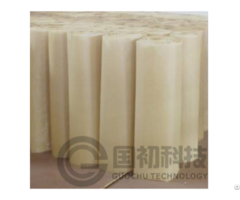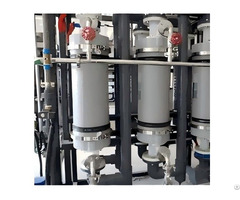Ion Exchange Membranes - China
price: 3000.00 Dollar US$
Electrodialysis (ED) is a very versatile technology for the separation of difficult mixtures.
Guo Chu technology (Xiamen) Co., Ltd. offers expertise in electrodialysis R&D as well as in the engineering and construction of ED systems for the laboratory, piloting, and production.
What is Electrodialysis (ED)? Electrodialysis is an electromembrane process in which ions are transported through ion permeable membranes from one solution to another under the influence of a potential gradient.
The electrical charges on the ions allow them to be driven through the membranes fabricated from ion exchange polymers.
Applying a voltage between two end electrodes can generate the required potential field.
Since the membranes used in electrodialysis have the ability to selectively transport ions having positive or negative charge and reject ions of the opposite charge.
Therefore, electrodialysis can achieve effective concentration, removal or separation of electrolytes.
The ion exchange membranes used in electrodialysis are essentially sheets of ion-exchange resins.
They usually also contain other polymers to improve mechanical strength and flexibility.
The resin component of a cation-exchange membrane would have negatively charged groups (e.g., -SO3–) chemically attached to the polymer chains (e.g., styrene/divinylbenzene copolymers).
Ions with a charge opposite to the fixed charge (counter ions) are freely exchanged at these sites.
The concentration of counter ions (e.g., Na+) is relatively high, therefore, counter ions carry most of the electric current through the membrane.
The fixed charges attached to the polymer chains repel ions of the same charge (co-ions), in this case the anions.
Since their concentration in the membrane is relatively low, anions carry only a small fraction of the electric current through a cation permeable membrane.
Attachment of positive fixed charges (e.g., -NR3+ or C5H5N+R where commonly R = CH3) to the polymer chains forms anion exchange membranes, which are selective to transport of negative ions, because the fixed -NR3+ groups repel positive ions.
This exclusion, as a result of electrostatic repulsion, is called Donnan exclusion.
Ion-exchange polymers such as poly(styrene sulfonic acid) are water soluble, so crosslinking is needed to prevent dissolution of ion permeable membranes.
Divinylbenzene is used to cross link polystyrene chains.
The degree of cross-linking and the fixed-charge density affect the membrane’s properties in opposite ways.
Higher crosslinking improves selectivity and membrane stability by reducing swelling, but it increases electrical resistance.
High charge density reduces resistance and increases selectivity, but it promotes swelling and thus necessitates higher crosslinking.
A compromise between selectivity, electrical resistance, and dimensional stability is achieved by proper adjustment of crosslinking and fixed-charge densities.
The following are our electrodialysis modules from small to industrial scale.
Ion Exchange Membranes Applications
Reduce Electrolyte Content: Potable from brackish water Food products – whey, milk, soy sauce, fruit juice Nitrate from drinking water Cooling tower water Boiler feed water Rinse water for electronics processing Electroless plating baths Recovery of blood plasma proteins Pickle brines to recover flavor Sugar and molasses Amino acids Potassium tartrate from wine Chloride purge in Kraft paper process Photographic developer regeneration Fiber reactive dyes
Recover Electrolytes: Pure NaCl from seawater Ag(I) salts from photographic waste Ni(II) from electroplating rinse water Zn(II) from galvanizing rinse water Salts of organic acids from fermentation broth Amino acids from protein hydrolysates Acids from metal pickling baths and rinse HCl from cellulose hydrolysate Miscellaneous: Salt splitting Metathesis Concentrate reverse osmosis brines Ion substitution As you can see, the ion exchange membranes have a wide range of applications in many fields.
Our experience with ion exchange membranes can help you determine whether it is the appropriate technology for your needs.
Contact:
Tel: +86 592 6514970 Skype:18060902001
WhatsApp:18060902001
WeChat:18060902001
TM: guochukeji
QQ:1641011431
Company Contact:
- Posted By: Guochu Technology
- Phone: +8618059282194
- Address: 海沧区翁角西路2072 号, XIAMEN , China
- Email:

- Website: https://www.guochukeji.com/
Published date: September 4, 2025
- Business Description: GUOCHU TECHNOLOGY (Xiamen) Co., Ltd. is a high-tech enterprise focusing on membrane technology as the core technique, dedicating to the development of new purification technology, for the biological pharmaceutical, food and beverage, fermentation industry, deep processing of agricultural products, plant extraction, petroleum and petrochemical industry, water treatment, air cleaning, chemical industry and other industries to provide comprehensive filter service and purification solution to fit the personalized requirement from different customers.
We are using our membrane technology, ion exchange, and liquid chromatography and other high-tech approaches to better serve our customers by integrating and improving their production line from upstream and downstream.
We are dedicating to be a professional service provider to help you find the solutions to reduce investment outlay, save running cost, decrease resource consumption, improve product quality, clean manufacture environment, and upgrade industries.
Related listings
-
 ElectrodialysisElectrical equipment and components - Guochu Technology - China - September 4, 2025 - 3000.00 Dollar US$
ElectrodialysisElectrical equipment and components - Guochu Technology - China - September 4, 2025 - 3000.00 Dollar US$Electrodialysis (ED) is a very versatile technology for the separation of difficult mixtures. Guo Chu technology (Xiamen) Co., Ltd. offers expertise in electrodialysis R&D as well as in the engineering and construction of ED systems for the labor...
-
 Diffusion Dialysis MembraneElectrical equipment and components - Guochu Technology - China - September 4, 2025 - 3000.00 Dollar US$
Diffusion Dialysis MembraneElectrical equipment and components - Guochu Technology - China - September 4, 2025 - 3000.00 Dollar US$Diffusion dialysis (DD) is an ion-exchange membrane (IEM) separation process driven by concentration gradient and has been applied for separation and recovery of acid/alkali waste solutions in a cost-effective and environmentally friendly manner. Dif...
-
 Profile MembraneElectrical equipment and components - Guochu Technology - China - September 4, 2025 - 3000.00 Dollar US$
Profile MembraneElectrical equipment and components - Guochu Technology - China - September 4, 2025 - 3000.00 Dollar US$GUOCHU TECHNOLOGY (Xiamen) Co., Ltd. is a high-tech enterprise focusing on membrane technology as the core technique, dedicating to the development of new purification technology, for the biological pharmaceutical, food and beverage, fermentation ind...
Safe Trade Tips
- Ask for business references and check them
- Use a payment method that offers better protection for all such as Letters of credit and verified professional escrow services. Avoid payments in advance such as money transfers
- Verify their business via their local Chamber of Commerce
- Search the internet using their website address, their business name, their phone and fax numbers, and their email addresses to see if you can find any feedback about them.
- Get to know more about scams and fraud to avoid: Internet Crime Complaint Center - Consumer Financial Protection Bureau
- This site is never involved in any transaction, and does not handle payments, shipping, guarantee transactions, provide escrow services, or offer "buyer protection" or "seller certification"
